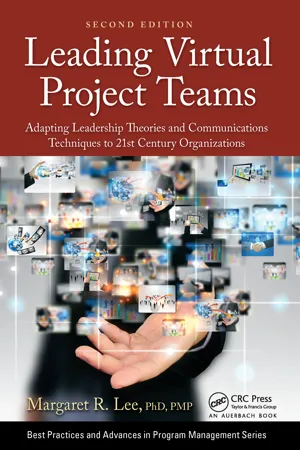
Leading Virtual Project Teams
Adapting Leadership Theories and Communications Techniques to 21st Century Organizations
- 200 pages
- English
- ePUB (mobile friendly)
- Available on iOS & Android
Leading Virtual Project Teams
Adapting Leadership Theories and Communications Techniques to 21st Century Organizations
About this book
The second decade of the 21st century has brought unprecedented challenges to traditional workplaces. The global pandemic has forced the advance of working from home and telework. Individuals with little or no background or training in e-leadership, virtual project management, or virtual team management suddenly found themselves in the environment of virtual work.
Leading Virtual Project Teams, Second Edition addresses the challenges that today's virtual project management environment poses to traditional methods of leadership and communication. Leadership for successful virtual team management is different from that for traditional, collocated project team management. Explaining appropriate e-leadership styles for virtual project teams and the transition toward new leadership styles, the book is filled with communication techniques for leading virtual project teams. It helps project managers develop e-leadership competencies needed to successfully deliver projects in today's organizations. The second edition also examines:
- Virtual meeting techniques
- Inclusive language
- Managing virtual relationships
- Why virtual work is now more important
- The work-at-home environment
By recognizing how virtual teams are different from traditional teams, those managing virtual projects may be able to offer benefits to their organization by providing positive, successful leadership and exceptional communications, resulting in better project deliverables and products. This book provides an approach that explores all facets of e-leadership—from how traditional leadership theories and models can be applied by 21st century leaders to providing methods by which the virtual project manager can enhance virtual project communications to meet the needs of our modern global business world. It features project management checklists and templates and includes business cases, best practices, and tools and techniques for virtual project management communications.
Frequently asked questions
- Essential is ideal for learners and professionals who enjoy exploring a wide range of subjects. Access the Essential Library with 800,000+ trusted titles and best-sellers across business, personal growth, and the humanities. Includes unlimited reading time and Standard Read Aloud voice.
- Complete: Perfect for advanced learners and researchers needing full, unrestricted access. Unlock 1.4M+ books across hundreds of subjects, including academic and specialized titles. The Complete Plan also includes advanced features like Premium Read Aloud and Research Assistant.
Please note we cannot support devices running on iOS 13 and Android 7 or earlier. Learn more about using the app.
Information
Chapter 1
Understanding Virtual
Overview
Introduction - Virtual Terminology

Table of contents
- Cover
- Half Title
- Series Page
- Title Page
- Copyright Page
- Dedication
- Contents
- Preface
- 1 Understanding Virtual
- 2 e-Leadership for Projects
- 3 Enhancing Virtual Project Communications
- 4 Cultural Communication Issues and Effective e-Leadership
- 5 Virtual Project Leadership Competencies
- Glossary
- Index